9 Places Designers Will Fall in Love with in Rome
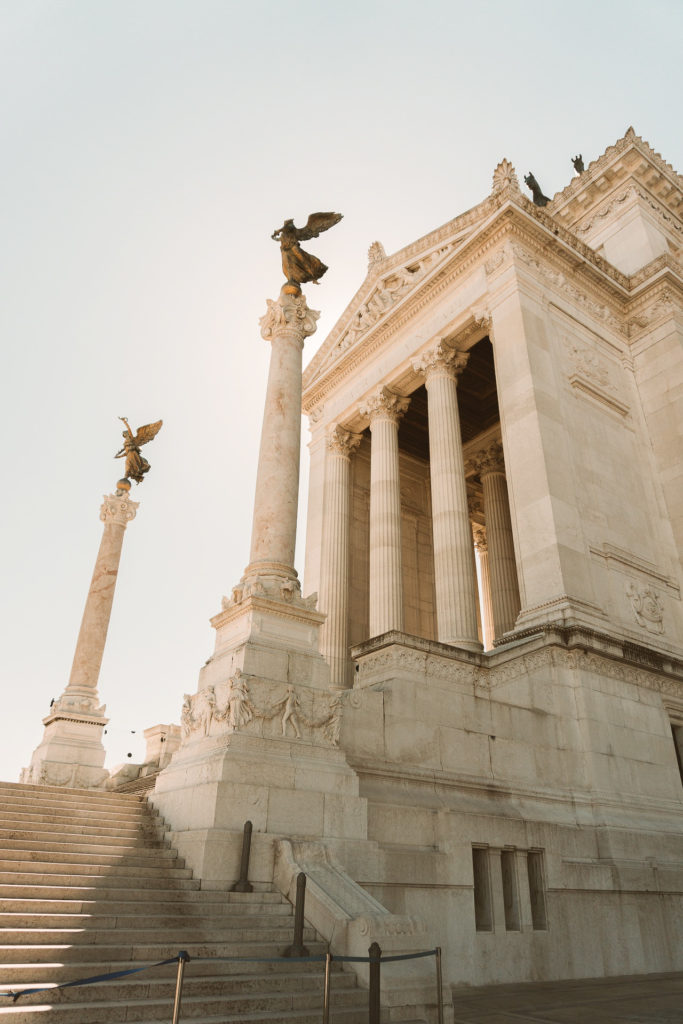
![]()
One word: ROME. You don’t have to be a designer to appreciate the artistry of this ancient city, but if you are, it probably has a whole different level of meaning for you. Today I want to share some of this incredible, life-changing city with you. (Literally, it changed my life 7 years ago.)
Whether you’ve seen Rome in person or seen it in photos, my goal is to share at least a few things — FOOD included — that you might not have encountered before. Some of these are well-known spots and suggestions. Others will help you avoid touristy spots, if you want to. (Nothing wrong with those, just offering more ideas!)
To do so, I’ve been helped by my husband, a native Italian and amateur historian (he reads history textbooks for “fun…”), who helped me see Rome from a different point of view this time.
![]()
1. The Roman Forum (Foro Romano)
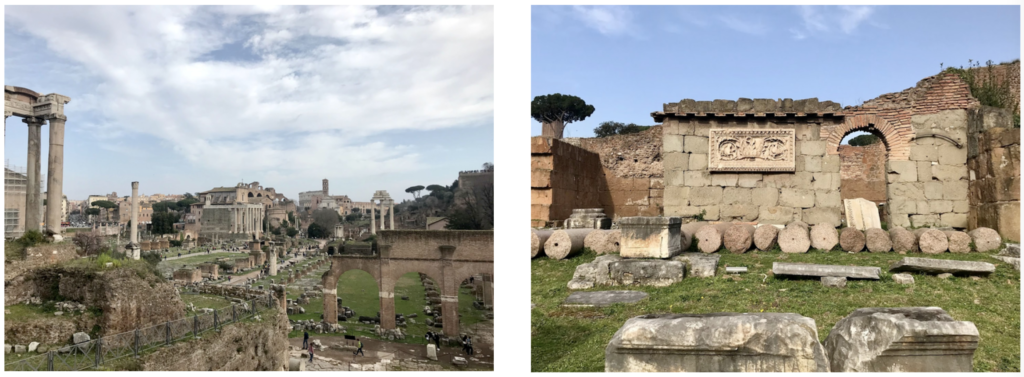
The Roman Forum is located right next to the Colosseum and is INCREDIBLE. I don’t know why more people don’t talk about it. The Colosseum is right next door (yes, it’s gigantic and impressive and you should see it at least once), but I found the Roman Forum to be far more transportive and breathtaking.
Imagine wandering the sprawling remains of an ancient city and marketplace: temples and streets, where people really lived, breathed, prayed, worked, sold their goods, plied their trades, and more. Real people. Like us. More than 2,000 years ago. Wow.
![]()
Pro Tips
-
Go right when it opens if you want this magical place to yourself.
-
If you’re planning to go to the Colosseum, buy your tickets for the Colosseum AT the Roman Forum entrance. The line is significantly shorter. When we got to the Colosseum, we bypassed hundreds of people who were waiting in line, and we walked right in.
![]()
2. Piazza Venezia
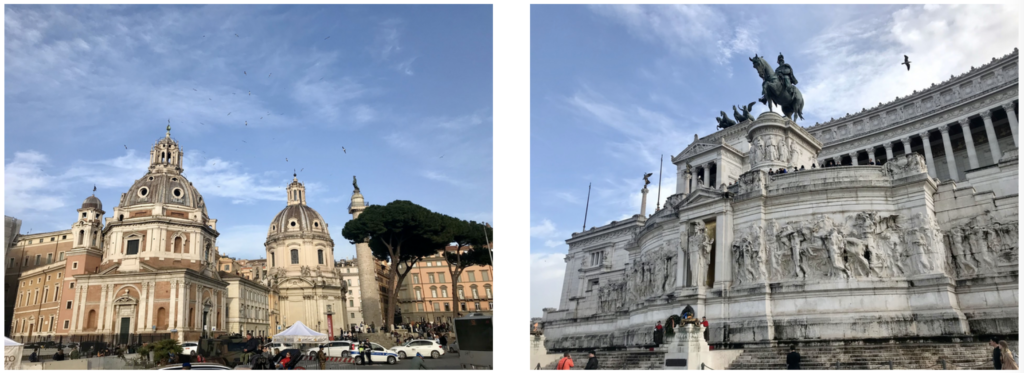
Piazza Venezia is behind the Roman Forum (opposite direction from the Colosseum). Pictured right is the Victor Emmanuel II National Monument. It is HUGE. Massive. Gargantuan. Words cannot describe the size of this palace and pictures do not do it justice. Just promise me you’ll go.
Pictured left is the Santa Maria di Loreto church, picturesque in the setting sun with warm tones, birds circling overhead, and right next to…
![]()
3. Trajan’s Market (Mercati di Traiano)
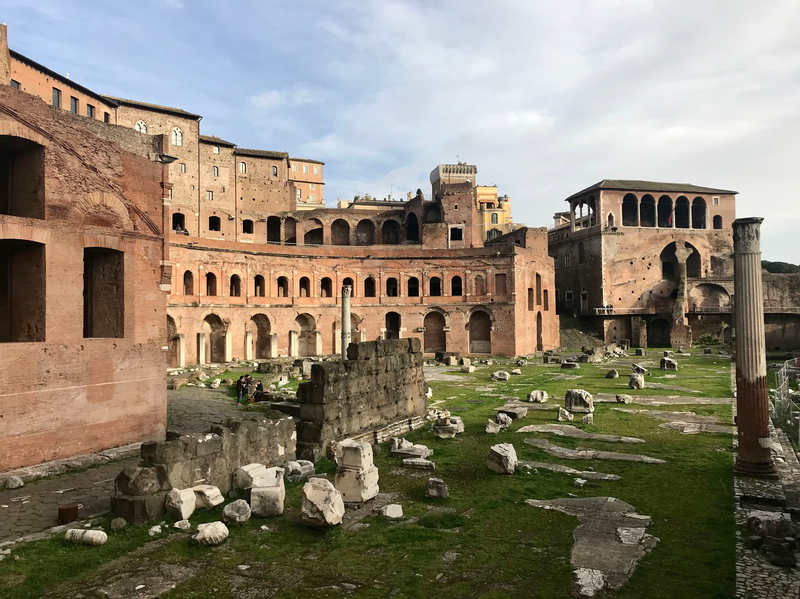
Trajan’s Market is believed to be the first multi-story, covered market in history. Built almost 2,000 years ago in 100 A.D., the market was (is?) 6 stories high and held more than 150 shops and apartments.
In fact, I did some reading, and it turns out that Trajan’s Market isn’t so different from the markets we enjoy today. They sold spices and food, wool and textiles, even luxury goods. Can we call it an ancient High Point Market? Maybe, maybe not… but it sure is interesting!
They host tours within the structure, but this grassy area you see is off-limits to all but caretakers… and surprisingly enough, a community of calico cats.
![]()
4. Capitoline Museum

If you’re fascinated by Roman history, stone sculptures, intricate interior design work, and Renaissance paintings, Capitoline Museum will not disappoint. Located at the far end of the Roman Forum (opposite the Colosseum), this museum is any artist’s or designer’s delight.
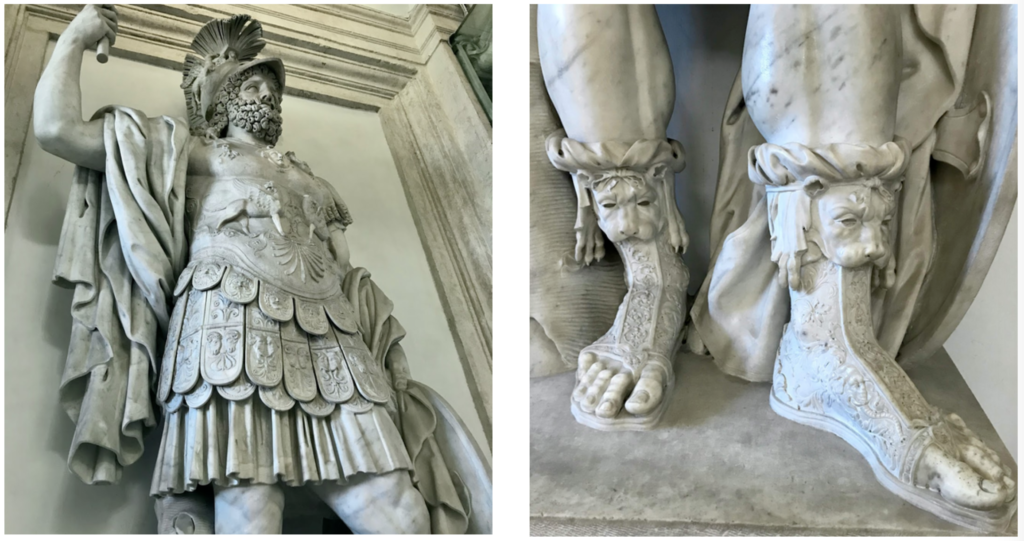
Marble statue of the god Mars, “Pyrrhus.” (I think we could all use pair of sandals like these!)
![]()
5. The Pantheon

Built in 113 A.D., the Pantheon is one of the few churches (initially Roman, later Catholic) that has continually been in use. You’ll notice that Rome has hundreds, if not thousands, of churches, but this one struck me as one of the oldest in appearance.
Granite, Corinthian columns have a darkness to them that feels old yet ageless. Inside, gorgeous marble stretches across the floors, internal columns, and much of the walls in shades of ochre (couldn’t resist), garnet, rose, charcoal, white, and grey.
Above it all, a dome and oculus shine light down into this massive space. In fact, I read that the Pantheon holds the record for the largest unreinforced concrete dome. So if you love natural stone and are willing to take the risk (kidding), the Pantheon will be a treat.
![]()
6. Piazza Navona
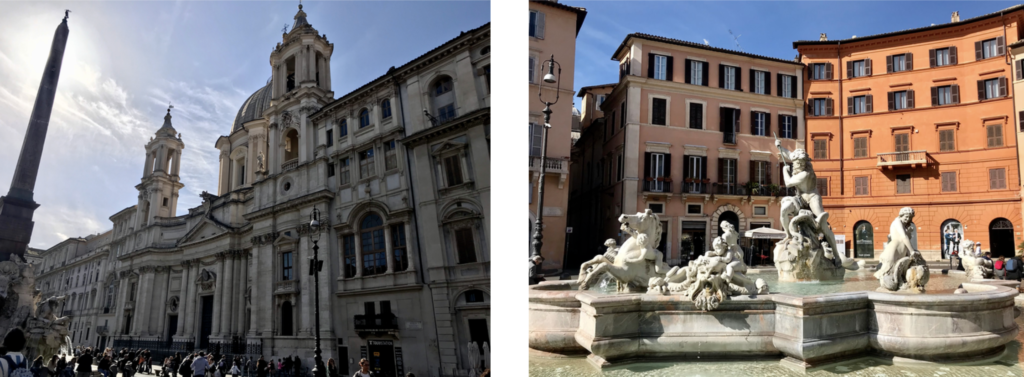
Built in the 1st Century A.D., Piazza Navona is one of the more famous plazas in Rome. Back in the day, townspeople would gather here to watch games. Now, it is full of shops, restaurants, lively music, the occasional theater performance, and visitors from all over the world.
![]()
7. Piazza del Popolo
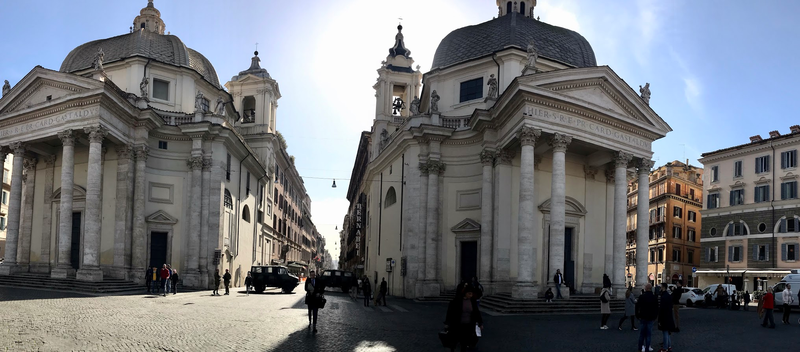
Piazza del Popolo is stunning up close, and if you take the stairs located across the plaza from the buildings pictured above, you can walk on up to get a great view of the city. Yes, you will be assailed by folks trying to sell you water, wares, or photos with them in their gladiator costumes, but the view is worth it! Just say “No, Grazie” (GRAHT-zee-ay) and they’ll leave you alone.
There’s also a really great sandwich shop just around the corner here called La Vita è Un Mozzico. You can find it at the end of this post.
![]()
8. Vatican City
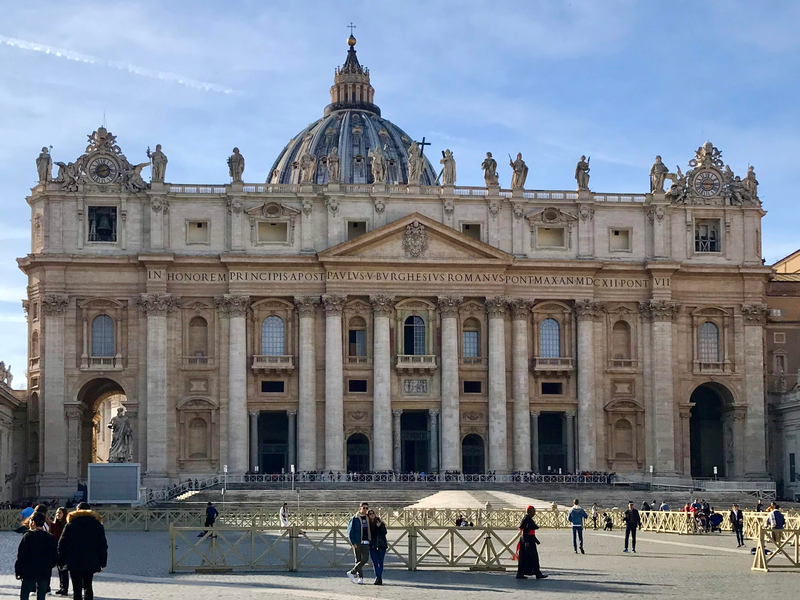
Whether you’re religious or not, the Vatican is a design wonder to behold. The architecture, stonework, and sheer size of the city is worth the visit. I wish I had gone to see the Sistine Chapel, but alas, I have zero patience when it comes to standing in lines. Design blasphemy, I know. Please go see it for me and tell me what you think.
![]()
9. San Clemente Church
I don’t have a picture of this one (I’ll share why below), but just imagine 3 LEVELS OF HISTORY on top of each other.
First, you walk into an expansive and impressive 12th Century basilica. Then you walk down a flight of stairs, and there’s another basilica from the 4th Century. And THEN, just when you think you’ve seen it all, you walk down another flight of stairs, and there’s a pagan temple and town from the 1st Century!
I’m of the opinion that if you’ve seen one basilica you’ve seen them all (or at least most of them), but this place was extremely memorable and you get 3 for 1. Lol. You can check Google photos here to get a taste!
Why don’t I have photos of this one? Well, I visited this church before my husband and I had met. When we were back in Rome together, I spun my most convincing tale to get him to see it again with me. The only problem? I got the name wrong…
We ended up in the “Capuchin Crypt” instead, which is exactly what it sounds like — a crypt — where everything from chandeliers to tables to chairs was made from… human bones. Very design relevant but really not my thing. Safe to say, he no longer takes my suggestions without a little research first. Which is fair.
![]()
Bonus: Random Side Streets
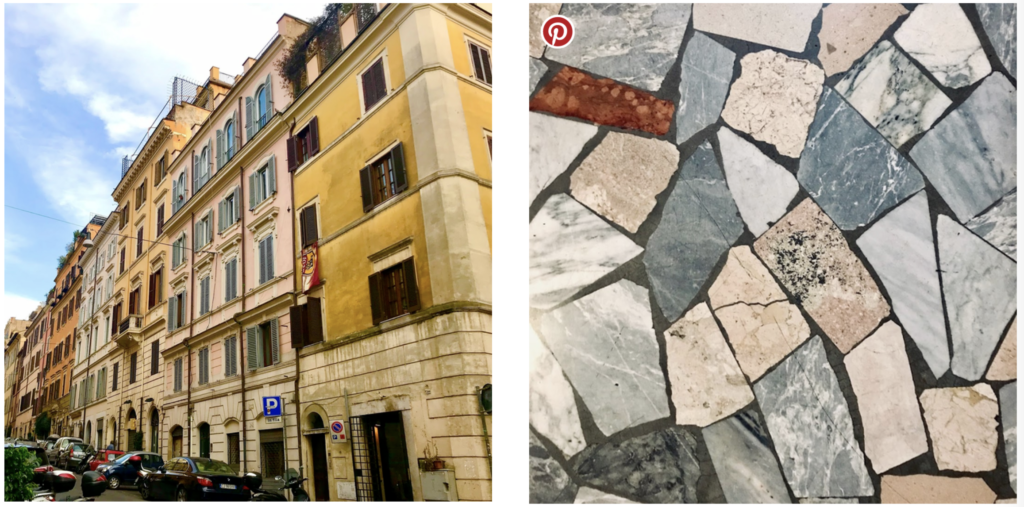
My last bit of advice is to just wander around. The architecture in Italy is so different from what we’re used to seeing in the U.S. You could pick any random street, start walking, and find something that takes your breath away, from surprising colors to natural terrazzo to obscure door knockers. So go on and explore!
![]()
3 Non-Touristy Places to Eat in Rome
We can’t talk about Rome without talking about food, right? There are a lot of places in Rome, especially in the city center, that cater to tourists and the food is definitely good, but I’ll let you in on a secret: the locals eat better.
If you’re looking for an authentic Roman experience, here are my suggestions. Okay, here are my husband’s suggestions, because let’s face it, without him and his well-trained Italian palate, I would have been at the touristy spots. (And definitely did on my first trip!)
![]()
1. Coffee: 089 Zer0ttoNove Café et Caffé
Delicious coffee, made with a real Neapolitan coffee machine. (My husband always appraises a cafe’s coffee machine before we decide to stay.) Turns out, he picked well, because we saw a famous Italian politician sipping his daily brew here. I ordered a café macchiato — like a creamy espresso shot — and it was so smooth!
![]()
2. Panini To Go: La Vita è Un Mozzico
This sandwich shop is incredible and right near Piazza del Popolo. This is another spot that was filled with Italian locals on their lunch break. Trust the locals. As we left, I also saw a photo of Bobby Flay eating at this place, so apparently it’s not the secret I thought it was. Still great, though.
What to Order: Definitely order the focaccia for the sandwich bread. For the inside, I loved mortadella with fresh ricotta, while my husband chose the porchetta with ricotta. If you’re looking for veggies (I walked in looking for grilled eggplant and bell peppers), this is definitely not the place for you.
![]()
3. Dinner: Ristorante Grano
Confession: We ran out of time and didn’t end up eating here, but I feel that it’s my solemn duty to help you avoid the tourist traps and eat at a real authentic Italian place. THIS was the one we had our eye on. They offer traditional dishes and some delicious looking creations of their own. Definitely feeling regret right now, so please do go and tell me how it is.
![]()
3 Distinctly Roman Dishes to Order
1. “Pinsa”
Pinsa is the Romans’ version of pizza. It’s rectangular, a slightly thicker crust, and a teensy bit smaller than a traditional Italian pizza. I was also told that it’s a “lighter” version of pizza. In case you’re wondering, I thought they were digestively similar. You’ve been prepared.
![]()
2. “Cacio e Pepe” and/or Carbonara
“Cacio” is pecorino cheese and “pepe” is black pepper. Put them together, and you have a pasta. I’m not a huge fan of plain pecorino, but I tried this combo on pinsa and pasta, and both were delicious! You can also up-level this dish to carbonara, also a specialty of Rome’s, if you’re not opposed to the addition of egg and guanciale bacon.
Native’s Tip: Authentic Italian carbonara does not have cream in it. Just eggs, bacon, parmesan, pepper.
![]()
3. Amatriciana
This Roman dish is like the “red” version of carbonara. The ingredients are similar (pecorino, guanciale) but with the addition of tomatoes. As a tomato lover, I preferred this one. BUONISSIMA.
![]()
That’s a wrap. I hope you found some surprises, some inspiration, and a colorful guide to bookmark and reference for your next trip. And in case you missed it… you can also find design inspiration from Japan here and from Switzerland here. Happy travels!
Ciao ciao,
Jaquilyn
WATCH the masterclass
WORKBOOKS & DOWNLOADS
A-to-Z LIST OF LUXURY WORDS
GUIDE TO BRAND MESSAGING
START BLOGGING FOR SEO
Printable Workbook
Our Go-To Lexicon!
Guide + Checklist